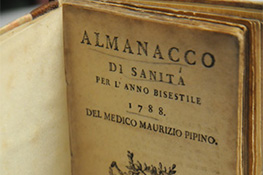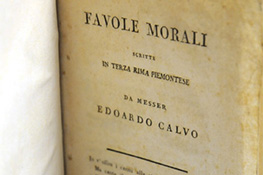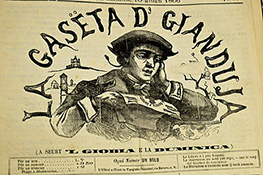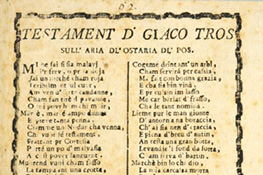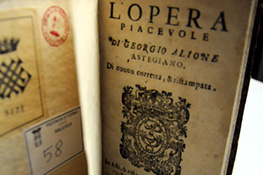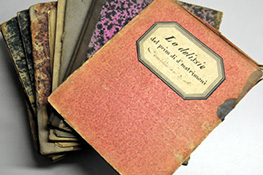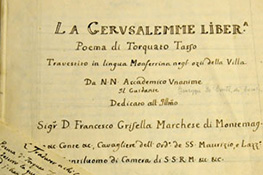Versione italiana English version Version française Versión en español
Acquired in 2001, it is made up of a vast collection of materials in Piedmontese language, lyrics, dictionaries, almanacks, theater texts collected by Erminio Morselli in over 20 years. It is a thousand composite pieces (books, manuscripts, leaflets, brochures, bargain pieces) that cover a time span from 1564 to 1930. The literature in Piedmont opens in a range of territorial variations, including the Monferrino, in which stands out the interesting manuscript of the canon and traveller Giuseppe De Conti, who in 1792 translated into dialect the Jerusalem liberated . This work is not the only representative of the interest in the epic of the Piedmontese authors: we also find the 'Aeneid of Fr. Virgil Maroun. Ocupassioun d'un pover vei giubilà. Liber secund , Piedmontese translation of the second book of the Aeneid, published in 1887. The effort is of the deputy of the Right Giuseppe Alasia (1820-1893), later prefect of Bari and secretary general of the Ministry of Education. There is also a vast repertoire of theatrical texts, almanacs and ballads in verse, built around the mask of Gianduia, who inspired an epic carnascialesca: that of Giandujeidi, with plot elaborated by Giacosa, which animated four performances held in Turin between 1868 and 1873, plus a fifth staged in 1893.
The very rare complete collection (1831-1849) by Parnas Piemonteis stands out in the corpus of materials , an almanac in prose and verse, "a treasure trove of household memories", "a significant compendium of literary production in the local language" (Gasca Queirazza) of those years, which however deliberately excludes the political argument but deals with the question of language and the codification of his handwriting. The presence of the Nigra Folk Songs and the Brofferio Piedmontese Songs (with the first edition in Lugano in 1839) is also inevitable.
Even the theatre is well represented thanks to the large presence of comedies, especially nineteenth-century, with the first edition (1887) of Miserie d'monsù Travet del Bersezio and the scripts of the Toselli Company, the actor and Garibaldi who founded the Piedmontese dialect theater. On the scripts, manuscripts, the mark of the comedian appears and often the duration of the show is marked.
Between 1763 and 1838 there are 15 sheets and a manuscript of rhymes Asti dedicated to the Palio d'Asti, 1788 is the rare Almanacco di sanità (in Italian) by the doctor Maurizio Pipino from Cuneo, who intended to compile a pocket-sized medical encyclopedia for the widest possible audience, and in particular for all those who found themselves in the need to rescue and treat the sick in places where medical facilities were scarce.
Interesting and very rare is also a collection of farces by the playwright Gian Giorgio Allione, active between the second half of the fifteenth century and the first twenty years of the sixteenth.
Of course, the 1802-1803 editions of Edoardo Calvo's Favole morali, a milestone in Piedmontese literature, and various songs by his predecessor and precursor Ignazio Isler, a Turinese Franciscan scholar who lived in the eighteenth century, harpsichord player and composer of savory popular ballads, a storyteller of the time in short.
The Fund also includes the dialectal dictionaries, from the oldest, the Promptuarium piemontese-latino by Michele Vopisco published in Mondovì in 1564, to Capello (Dictionnaire portatif piemontais-français) of 1814 to Zalli (Disionari Piemonteis/Italian/latin/franseis) 1830 to the Ponza (Piemontese-italian Vocabulary) of the same year, until the fundamental Sant'Albino (piemontese-italiano Gran Dictionary) of 1859. Also present is Bernardino Biondelli's Gallo-italic dialect essay (Milan 1853).
In addition to the materials of the Morselli Collection, the Library also has a number of vocabularies in which the different variants of Piedmont, Vercelli, Acquese, Alessandrino, Monferrato and Vogherese are represented, Valsesian, a dictionary of the dialect of Novi Ligure and the Waldensian of Val Germanasca, a "Collection of old words gattinaresi" and even a castellano-Piemonteis and a slang "Vocabularies of the mala".
Maurizio Pipino's almanac
Maurizio Pipino, a doctor from Cuneo, was the author of the first Piedmontese grammar, the first vocabulary (four languages: Piedmontese, French, Latin and Italian) and the first poetic anthology (the latter containing the twenty-four most beautiful songs of Father Isler), published all in Turin in 1783. He died of the plague in 1788 on the island of Symi (near Rhodes) while en route to the Indies. From 1786 Soffietti, in Turin, printed a "Almanacco di Sanità" of which the Historical Library has the very rare specimen published "for the bistestile year 1788". In this issue Pepin discusses the diseases of autumn, their causes, possible cures. " This is the most unhealthy season of the year" - he writes - "Quartan and intermittent fevers are longer to heal; chronic diseases tend to worsen and people die there more frequently [...] whence was born our proverb Al groê dle feuje: Al cader delle foglie...". For "the abundance of humors" he recommends bloodletting, for ills caused by fungi (seasonal dangers), emetics and purgative.
At the end of the almanac, a small anthology of Piedmontese rhymes: in this issue we find a version in the well-known poem L'arpa dëscordà, attributed to the priest Francesco Antonio Tarizzo. Of this epic-historical composition, which is narrated in almost two thousand verses of the siege and liberation of Turin in 1706, the choral protagonist is the people, both in language and in the story.
Edoardo Calvo
Born in Turin in 1773 and died there in 1804, by typhus contract assisting his patients (he was a doctor at the San Giovanni hospital), Edoardo Calvo is the greatest poet in Piedmontese dialect. Jacobin, persecuted for his ideas, twice exiled to France, exponent of the Enlightenment youth, proponent of a free Italy and one, author of one of the most robust Italian revolutionary songs, Passaport dj' aristocrat, could not stand the Napoleonic Caesarism and the reactionary Savoy. Calvo is one of the most important Italian satirical poets who wrote in dialect, his Favole morali are of 1802. Under the guise of the animals of the traditional fable, the historical figures against which the poet leads a sarcastic and lashing indictment. In Sansue and 'l bòrgno (The bloodsuckers and the blind) he overshadows the French (in the bloodsuckers) while they suck the blood of a blind man (Piedmont), who deluded himself welcomed them as humanitarian reformers and is likely to die bleeding: (...) Sta fàvola, che i lese 'n sghignassand, / When he was looking from with the tai / ch'a vivo për el mond an crijassand: / Balsamo e sparadrap për tuti mai! (This fairy tale, which you read laughing, / means that you must beware of those / who roam around the world: / Balms and miraculous patches against all evils!).
The Giandujeidi
Between 1868 and 1872, four events were held in Turin in honor of Gianduja, during the Carnival: they went on stage along Via Po, in the form of a pantomime between historical re-enactment and invention, according to a plot created by Giuseppe Giacosa. They went from the discovery of Gianduia among the leaves of a colossal cabbage in the square of Callianetto, with subsequent fall in a vat full of barbera, to his heroic feats during the resistance of the citizens of Viù against the invasion of Hannibal. A fifth took place in February 1893 and involved 1500 actors in costume.
Among the papers of the Fondo Morselli, Gianduja's epic is well represented with a varied collection of materials. For example, we find the complete 1866-67 vintages of La Gazeta d'Gianduja, a bi-weekly dialogue and poetry on current history, with "masks" or "types" in contrast, "photographs of Turine life", macro- and micro-news. Pietracqua collaborated there, with stories and poems. Then there are the Almanacch (year 1868 and 1870), calendars to 5 cents each, the score of La Giandujeide, carnascialesca song, words by Cesare Scotta and music by Giuseppe Stella, to 50 cents. And also the famous cards that wrapped in hexagonal shape the flat Gianduja candies of various sizes.
Ignazio Isler
Franciscan father from Turin, belonging to the Order of the Trinitarians shod in the convent of Crocetta, Ignazio Isler (1702-1788) wrote in the dialect of the time a large series of poems and songs (he was also a musician and cymbal player)farces and comedies of a profane and popular character and satirical tone. Satire is, moreover, one of the keystones of Piedmontese literature, from the ancient Allione to the Isler, from the Calvo to the Brofferio to the Rosa. In the songs of the Isler are crowded city specks and peasant simpletons, all that childish world that we find in genre paintings of the time, made in a vivid language, fat, salacious, but of penetrating appropriateness. There are many characters typical of his ballads, including Barba Giròni and Martin Potagi, Lucressia Gilofrada and her three daughters and that Giaco Tross great drinker who in his Testament recommends being buried in the cellar. Cause of death, once drinking water from the well instead of wine from the barrel.
Gian Giorgio Allione
Astigian, began to write around 1490 and published in 1521 his Opera iocunda, including some rhymes in dialect and in French, plus a macharonata, but above all a number of original farces and irreverent, far from the spirit of the humanistic era and from what will be the popular epic of the Ruzante, but still of medieval layout, with probable influences of French theater and carnascialesche traditions. Among his ten farces, which constitute the first example of theatre in Piedmont, it is worth mentioning above all the "Comedia de l'homo e de soi cinque sentimenti", an apology in which it is shown that all the senses with which man is endowed have equal importance.
The Toselli's company
In 1857 Giovanni Toselli (1819-1886), an actor from Cuneo, from Garibaldi in 1848, formed his Compagnia Drammatica Nazionale. Encouraged by Gustavo Modena, in whose company he was an actor and secretary, he devoted himself to dialect theatre. He became very popular and for him wrote well-known authors of the Piedmontese scene (Garelli, Zoppis, Pietracqua, Chiaves) and many actors also in the language were trained at his school. With his company he went on stage for the first time, on 4th April 1863 at the Alfieri Theatre in Turin, Le miserie'd Monsu Travet by Vittorio Bersezio. Thus the author describes that event:
"On the beautiful first day of Lent the Company read the play, and then for thirty and more days, with a few rest trammezzo, it was tried, in detail first, then in the whole, scene by scene, act by act, until the director was persuaded that each and every one was the master of their part and they knew, until the slightest gesture, what he had to do.
A week before Easter, Toselli declared that the play was ripe: those last days he let the Company rest; he made a great rehearsal on Good Friday, and on Saturday evening it was staged. The parts were distributed as follows: Monsù Travèt, Toselli; Madama Travèt, Morolin; Marianin, Morino the youngest; Brigida, Morino the elder; Carlin Travèt, Clara Toselli; 'L Comendator, Ferrero; 'L Cap-Milone; Session Giachëtta, Penna; Paolin, Vado; The two employees, Cavalli and Alessio. The expectation was great. [...]". The first did not go well, but from the second evening onwards the comedy was a success, much of which was due, writes Bersezio, "certainly to the excellence of the performance. Toselli, who had spent so much time and so much care in studying and making the Company study comedy, immediately regained the success of the second evening by the discouragement that had produced the bad outcome of the first, continued to put in that part all the best of his ingenuity, always improving, always adding new colors, new lines to that color, to that design, that gave you no longer an image, but a real person, embellished by the light of art. Among those who supported that character, no one came to equal Toselli, no one embodied with so much evidence, with such right guessing the fantastic being that for many days had occupied the mind of the author".
Toselli finally, at the height of his success, wanting to demonstrate his attachment to the city of Cuneo, built at his expense a theater that will be called "Summer Theater", inaugurated on 14th July 1874 and active especially in the summer months with popular performances. But, after a period of success, the structure, burdened by passivity, had to be sold by Toselli to the City (for 35,000 lire), and after the death of the comedian took the name of "Toselli Theatre".
The liberated Jerusalem in Monferrato's dialect
In a bibliographical review conducted in 1966 by Alessandro Tortoreto, there are about fifteen translations, in various Italian dialects, of the liberated Jerusalem. The chronological extension goes from 1628 (ancient Bolognese) to 1948 (Sardinian), and also includes the unpublished manuscript of the canon Giuseppe De Conti, vicar of the Diocese of Casale, who lived between the end of the eighteenth and the beginning of the 19th century (died in 1819). The work, dedicated to the Marquis Francesco Grisella, is an integral translation of Tassiano's poem in Monferrato dialect. The author, a member under the pseudonym of Il Guidante of the Accademia degli Unanimi of Turin, was a singular scholar with historical interests, who also left us interesting studies such as the Portrait of the City of Casale (1794, folio manuscript) and even an opera libretto, also in Monferrato dialect, La difesa di sei terre del Monferrato nella fuga del Duca di Mantova (1780). In 1774, on the occasion of the Jubilee of the following year, he left for Rome in the company of a friend and colleague and a servant: of this journey, with many stages and deviations, including Naples and Venice, De Conti wrote a diary, a mosaic of reflections and testimonies on Italy of the time, published in 2007 by Interlinea.
The Jerusalem translated by De Conti dates back to 1792 and has 427 pages. The author provided to replace the epic and pathetic tone of the Tasso with a popular language, but not vulgar, using for the similarities Casalese settings and trying to claim the indigenous ancestry of certain characters, such as Tnacredi, qualified "of the prosapia of the ancient Alerami, marquises of Monferrato" (and monferrinizzando so the Crusaders to its continuation). The popular tone of the translation can be seen from the first stanza, in which Goffredo di Buglione is made Cap d'l'armada anss i doi pè. Then there are numerous references to Casalese life of the time, as in the thirteenth verse the description of the archangel Gabriel who in flight was more alger of a Balon volant: image that refers to the first balloon that rose in Casale in 1783 in front of a public admired and stunned.
- Inventory (pdf 304 KB)

